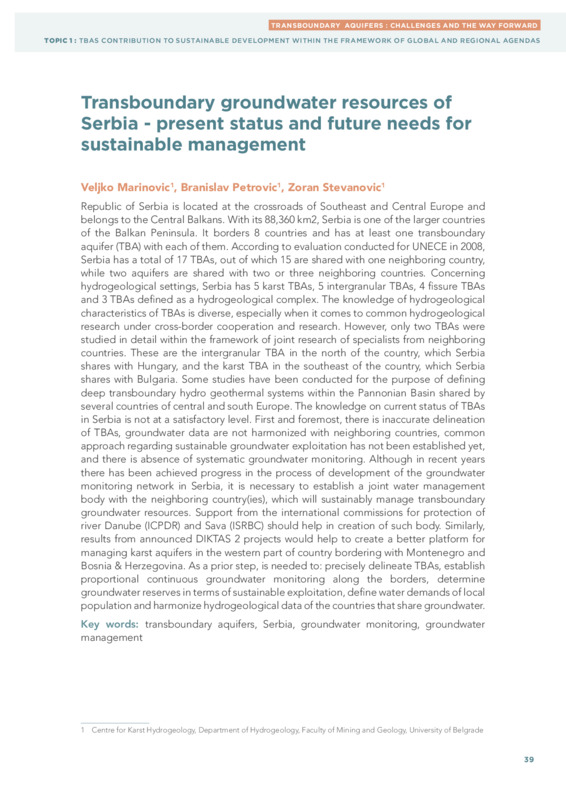Transboundary groundwater resources of Serbia - present status and future needs for sustainable management
Објеката
- Тип
- Саопштење са скупа штампано у изводу
- Верзија рада
- објављена
- Језик
- енглески
- Креатор
- Veljko Marinović, Branislav Petrović, Zoran Stevanović
- Извор
- Second International UNESCO Conference on Transboundary Aquifers, “ISARM2021: Challenges and the way forward”, Paris 2021
- Уредник
- Alfonso Rivera, Alice Aureli, Shammy Puri
- Издавач
- United Nations Educational, Scientific and Cultural Organization, 7, place de Fontenoy, 75352 Paris 07 SP, France
- Датум издавања
- 2021
- Сажетак
-
Republic of Serbia is located at the crossroads of Southeast and Central Europe and
belongs to the Central Balkans. With its 88,360 km2, Serbia is one of the larger countries
of the Balkan Peninsula. It borders 8 countries and has at least one transboundary
aquifer (TBA) with each of them. According to evaluation conducted for UNECE in 2008,
Serbia has a total of 17 TBAs, out of which 15 are shared with one neighboring country,
while two aquifers are shared with two or three neighboring countries. Concerning
hydrogeological settings, Serbia has 5 karst TBAs, 5 intergranular TBAs, 4 fissure TBAs
and 3 TBAs defined as a hydrogeological complex. The knowledge of hydrogeological
characteristics of TBAs is diverse, especially when it comes to common hydrogeological
research under cross-border cooperation and research. However, only two TBAs were
studied in detail within the framework of joint research of specialists from neighboring
countries. These are the intergranular TBA in the north of the country, which Serbia
shares with Hungary, and the karst TBA in the southeast of the country, which Serbia
shares with Bulgaria. Some studies have been conducted for the purpose of defining
deep transboundary hydro geothermal systems within the Pannonian Basin shared by
several countries of central and south Europe. The knowledge on current status of TBAs
in Serbia is not at a satisfactory level. First and foremost, there is inaccurate delineation
of TBAs, groundwater data are not harmonized with neighboring countries, common
approach regarding sustainable groundwater exploitation has not been established yet,
and there is absence of systematic groundwater monitoring. Although in recent years
there has been achieved progress in the process of development of the groundwater
monitoring network in Serbia, it is necessary to establish a joint water management
body with the neighboring country(ies), which will sustainably manage transboundary
groundwater resources. Support from the international commissions for protection of
river Danube (ICPDR) and Sava (ISRBC) should help in creation of such body. Similarly,
results from announced DIKTAS 2 projects would help to create a better platform for
managing karst aquifers in the western part of country bordering with Montenegro and
Bosnia & Herzegovina. As a prior step, is needed to: precisely delineate TBAs, establish
proportional continuous groundwater monitoring along the borders, determine
groundwater reserves in terms of sustainable exploitation, define water demands of local
population and harmonize hydrogeological data of the countries that share groundwater. - почетак странице
- 39
- Subject
- međugranične izdani, Srbija, monitoring podzemnih voda, upravljanje podzemnim vodama
- transboundary aquifers, Serbia, groundwater monitoring, groundwater management
- Шира категорија рада
- М30
- Ужа категорија рада
- М34
- Права
- Отворени приступ
- Лиценца
- All rights reserved
- Формат
Veljko Marinović, Branislav Petrović, Zoran Stevanović. "Transboundary groundwater resources of Serbia - present status and future needs for sustainable management" in Second International UNESCO Conference on Transboundary Aquifers, “ISARM2021: Challenges and the way forward”, Paris 2021, United Nations Educational, Scientific and Cultural Organization, 7, place de Fontenoy, 75352 Paris 07 SP, France (2021) М34
This item was submitted on 23. децембар 2021. by [anonymous user] using the form “Рад у зборнику радова” on the site “Радови”: http://romeka.rgf.rs/s/repo
Click here to view the collected data.
